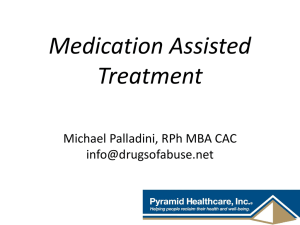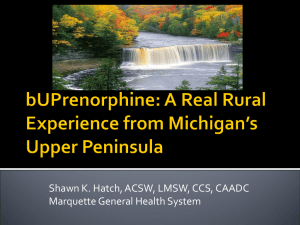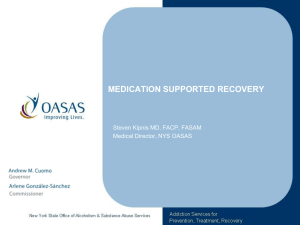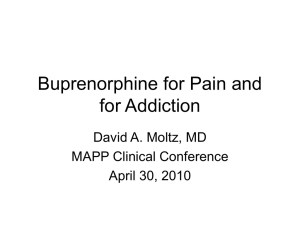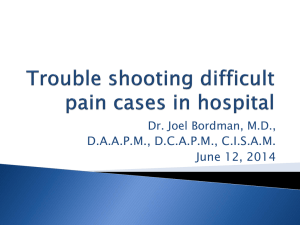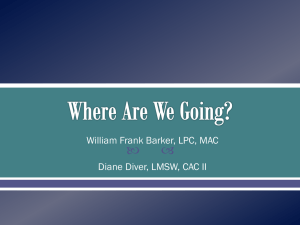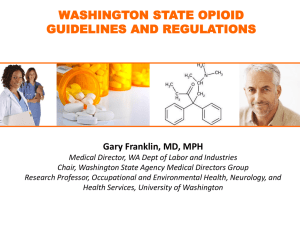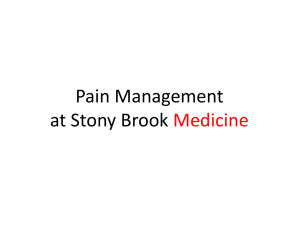Curriculum Slides
advertisement
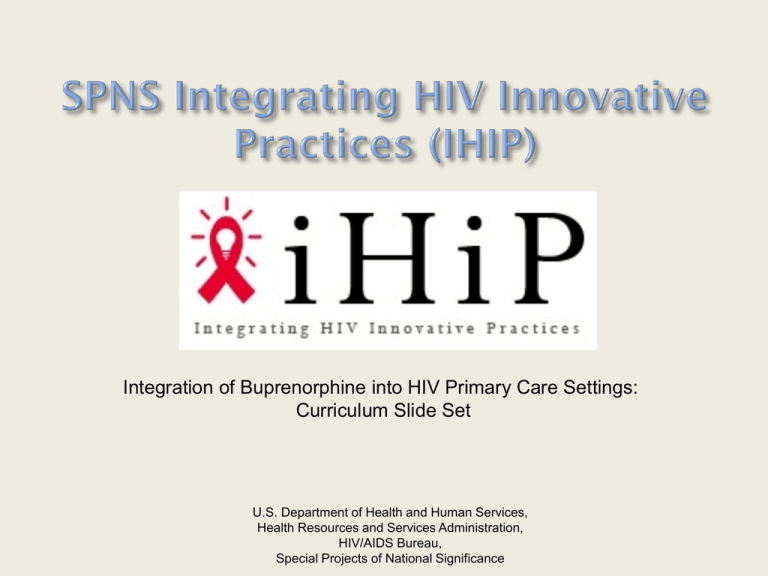
Integration of Buprenorphine into HIV Primary Care Settings: Curriculum Slide Set U.S. Department of Health and Human Services, Health Resources and Services Administration, HIV/AIDS Bureau, Special Projects of National Significance The Diagnostic and Statistical Manual - IV (DSM-IV) describes addiction as “a maladaptive pattern of substance use, leading to clinically significant impairment or distress, as manifested by three (or more) of the following, occurring at any time in the same 12month period: (1) Tolerance, as defined by either of the following: (a) a need for markedly increased amounts of the substance to achieve intoxication or desired effect (b) markedly diminished effect with continued use of the same amount of the substance. 2) Withdrawal, as manifested by either of the following: (a) the characteristic withdrawal syndrome for the substance (b) the same (or a closely related) substance is taken to relieve or avoid withdrawal symptoms. (3) The substance is often taken in larger amounts or over a longer period than was intended. 4) There is a persistent desire or unsuccessful effort to cut down or control the substance use. (5) A great deal of time is spent in activities necessary to obtain the substance, use the substance, or recover from its effects. (6) Important social, occupational, or recreational activities are given up or reduced because of the substance. (7) The substance use is continued despite knowledge of having a persistent or recurrent physical or psychological problem that is likely to have been caused or exacerbated by the substance. Source: American Psychiatric Association. Diagnostic and statistical manual of disorders. Fourth edition, text revision. Washington, DC, 2000: author. Substance use is associated with: increased sexual risk behaviors, increased HIV risk and poorer health outcomes, contributing to destabilizing conditions, (e.g. homelessness and mental illness). HIV, injection drug use (IDU), and opioid addiction are intertwined. Since the beginning of the epidemic, one-third of all AIDS cases have been directly or indirectly related to IDU. For people with HIV, untreated opioid addiction is associated with poor HIV treatment outcomes and a host of other medical, psychosocial, and legal consequences. IDU (either directly or via sexual contact with an IDU partner) accounts for 1/3 of cumulative est. AIDS cases, and 18 percent of new infections in the United States. In the United States, there are an estimated 2.4 million opioidaddicted people. According to a 2010 Substance Abuse and Mental Health Services Administration (SAMHSA) national study, dependence/abuse of pain relievers ranked second (after marijuana) among illicit drug use in the past year. Heroin ranked fifth. National data, as well as clinical experience from a SPNS Buprenorphine Initiative grantee suggest prescription opioid abuse may be proportional to the number of opioid prescriptions written. Opioids are natural, fully semisynthetic/entirely manmade drugs. Opioids diminish the perception of and reaction to pain. They also produce feelings of euphoria. Heroin and some prescription medications (such as morphine, fentanyl, oxycodone, codeine, methadone and buprenorphine) are opioids. According to one SPNS study grantee, prescription opioid abuse may be proportional to the number of opioid prescriptions written to HIV-positive patients. Opioids bind to and activate receptors in the brain, triggering the release of dopamine—a neurotransmitter linked with learning, pleasure, and reward. Over time, opioid use changes both the amount and sensitivity of dopamine receptors in the brain, leading some people to try to restore dopamine levels by continuing their drug use. Medication-Assisted Treatment (MAT) is “the use of medication such as methadone or buprenorphine in combination with counseling and behavioral therapies to provide a whole-patient approach to the treatment of opioid dependence.”* MAT is an integral part of comprehensive HIV services for opioid-addicted PLWHA. MAT—combining pharmacotherapy and counseling—can improve HIV and addiction-related outcomes. *Source: Cheever LW, Kresina TF, Cajina A, et al. A model Federal collaborative to increase patient access to buprenorphine treatment in HIV primary care. JAIDS. 2011;56 (Suppl 1):S3. “With buprenorphine you just feel like you’re just normal. It’s kind of like it takes me back to before I had ever done [opioids].” “Seemed like when I got on the program, everything just came—the sun came out. This is so cliché, but I started smelling the flowers. You know, I just, I started loving myself.” Buprenorphine “makes me take care of [my HIV] more. If I have to take my buprenorphine every morning, then I have to take my medications every morning. I remember and I can take it all together. I eat, take my vitamins, take my meds, take my buprenorphine, and then I go.” Reference: Egan JE, Netherland J, Gass J. Patient perspectives on buprenorphine/naloxone treatment in the context of HIV care. JAIDS. 2011;56(Suppl 4):S48. Methadone is a full opioid agonist. It prevents withdrawal symptoms by binding to and fully activating opioid receptors; higher doses reduce cravings for, and effects of, other opioids. Methadone is administered only by accredited, certified opioid treatment programs (OTPs) or methadone clinics; some OTPs also provide buprenorphine. OTPs are highly structured programs. Buprenorphine is a partial opioid agonist, so it does not fully activate opioid receptors; therefore, its effects are milder. Buprenorphine works by displacing other opioids from their receptors and binding to the same receptors, thereby preventing withdrawal symptoms and drug cravings while blocking the effects of other opioids. Buprenorphine can be offered within primary care settings by qualified physicians. Suboxone is a co-formulation of buprenorphine and naloxone, available as a tablet or film; both are administered sublingually. Naloxone reverses overdose by binding to—and blocking—opioid receptors. Sublingual naloxone is poorly absorbed, but when injected, naloxone causes immediate onset of withdrawal symptoms. Naloxone was added to buprenorphine to reduce the risk of diversion; Suboxone is the preferred form of treatment (over buprenorphine monotherapy). Suboxone tablets are orange, hexagonal pills. Suboxone tablets and film contain buprenorphine and naloxone in a 4:1 ratio. Partial agonists have a more favorable safety profile than full agonists. Risk of overdose is lower due to a “ceiling effect,” meaning increasing buprenorphine dose will not increase effects. Overdose risk increases when buprenorphine is used with alcohol, benzodiazepines, and other opioids. Drug-drug interactions: Can be safely used with most HIV medications, although monitoring and dose adjustment may be needed with certain drugs. Buprenorphine withdrawal symptoms are less severe. Can be used on an inpatient basis with medical supervision. Transitions people from physical dependence to non-dependence. Detox inpatient use was NOT studied in HRSA/HAB SPNS initiative on buprenorphine in HIV primary care settings. Naltrexone is an opioid antagonist and another MAT option. Older forms of naltrexone used less commonly because of poor adherence. New extended-release injectable form, however, recently released from FDA. Offers new promise for adherence and can be offered in primary care settings. SAMHSA released new advisory: http://store.samhsa.gov/shin/content//SMA 12-4682/SMA12-4682.pdf These medications have shown effectiveness and have demonstrated benefits to individuals and society. Some patients prefer methadone to buprenorphine, or injectable naltrexone. There is no“one size fits all.” SPNS Initiative overview 5 years Ryan White HIV/AIDS Program sites 10 grantees Best practices compiled into monograph, training manual, and online wiki. (Monograph can be accessed at: www.hab.hrsa.gov/abouthab/files/hab_spn s_buprenorphine_monograph.pdf.) Increased collaboration Improved communication Increased comprehensive care offerings Intersection of opioid use and HIV incidence and transmission Improved retention among disenfranchised populations. Providers and patients were overwhelmingly satisfied with results. Improved HIV medication adherence and viral load. Reduced risk behaviors. Improved overall health outcomes. Patients felt incredibly lucid and stated improved quality of life and social functioning. Patients were increasingly receptive to buprenorphine offerings, especially once they were better educated about withdrawal state, level of cravings, and other information about buprenorphine administration and continuation. Providers found administration of buprenorphine easier than expected. Medical and support staff found integration of substance abuse treatment into their clinics beneficial rather than burdensome. In one grantee site study among 93 HIV-positive, opioid-dependent patients who were assigned either to clinic-based buprenorphine and individual counseling or to case management with referral to drug treatment, people in the buprenorphine group were: • Significantly more likely to participate in treatment for opioid dependence (74 percent versus 41 percent), • Less likely to use opioids and cocaine, • More likely to attend their HIV primary care visits than were people in the group referred to drug treatment. The University of California, San Francisco, Positive Health Program at San Francisco General Hospital SPNS grantee “found that the buprenorphine induction process was feasible and went well. They induced patients with many years of heroin use, high-dose heroin use, methadone use, and cocaine use.” One patient participant stated, “It couldn’t be better, and here’s the reason why: if it’s something with either one of them [drug use or HIV], right, by your medical people and your program [being] in the same building, I can always go to my doctor and find out what combination, how this is working with this and that.” References: HIV/AIDS Bureau, Special Projects of National Significance Program. Integrating buprenorphine therapy into HIV primary care settings. Rockville, MD: U.S. Department of Health and Human Services; 2011. Available at: www.hab.hrsa.gov/abouthab/files/hab_spns_buprenorphine_monograph.pdf. Egan JE, Netherland J, Gass J. Patient perspectives on buprenorphine/naloxone treatment in the context of HIV care. JAIDS. 2011;56(Suppl 4):S48. DATA 2000 Landmark legislation Enabled qualified physicians to prescribe FDAapproved Schedule III, IV, and V opioid medications. Buprenorphine is a Schedule III narcotic. (To read the full law, visit www.buprenorphine.samhsa.gov/fulllaw.html) Who can prescribe buprenorphine? Qualifying physicians What training is necessary? Required board specialty, or 8 hours of approved training Notify SAMHSA for waiver to treat If approved, receive notice and DEA registration number First year=maximum treatment of 30 patients per authorized physician. After first year, may apply for additional waiver to treat up to 100 patients. Communication is key. Secure buy-in up front from clinic and local partners as well as organizations with vested interest in patient population. Identifying and addressing structural barriers. Counseling: mental health and support groups Patient and provider education Evaluation component Team approach and buy-in vital. SPNS grantee sites relied primarily on dyad model: Prescribing physician and Clinical coordinator (i.e.,“glue person”) See figure for possible glue person responsibilities. BUP Patient Toxicology Screens Case Management Clinical Coordinator Medical Provider Opioid Substitution External Substance Abuse Programs 1. Induction 1. Stabilization 1. Maintenance Induction is done under medical supervision. Patient must be in early withdrawal to undergo induction. This is because buprenorphine causes acute withdrawal in patients with opioids in their bloodstream. During stabilization: Reduce patient opioid use. Adjust buprenorphine dosage as necessary. Reduce withdrawal symptoms. Monitor patients. There is no “one size fits all” length of time for the maintenance phase. Counseling is very important during this phase. Patients discontinuing buprenorphine must be tapered off gradually. What are Opioids? Opium is the source of natural opioids like heroin. Some opioids are man-made, like OxyContin and methadone. heroin Morphine MS Contin propoxyphene Darvon/Darvocet oxycodone Oxycontin & Percocet Buprenorphine hydrocodone Vicodin Codeine Tylenol # 3 methadone Dolophine meperidine hydromorphone Demerol Dilaudid Opioids may be taken by mouth, through the skin (patch), or by a needle into the fat, muscle, or vein. They attach to special opioid receptors in the brain where they help to relieve pain. Some opioids cause euphoria (“high”) and sleepiness or, if taken in large amounts, unconsciousness that may progress to death (overdose). Other side effects may include itching, headache, nausea, constipation, confusion, slow pulse, and slow breathing. Some opioids last a few hours and some more than a day. Any person who uses opioids regularly may become physically dependent on them. This means that you need more drug over time to get the same effect (tolerance) and that you have withdrawal symptoms if you stop using the drug. When you use more drug than prescribed/needed to control your pain… When you begin to spend more and more of your time seeking your drug of choice… When you consistently choose drug use over social activities and responsibilities… From Physical Dependence to Addiction When you endure the negative consequences of ongoing drug use but don’t seek change… When you try to stop using drugs but cannot… it is likely that you are living with addiction. What Does It Feel Like to Be Opioid Dependent? Over time, nerve cells in the brain learn to crave opioids. When opioids are not present, the opioid receptors send pain signals to the rest of the brain (withdrawal). This is a physical condition, not caused by a lack of willpower or morals and not cured by good advice. Addiction is a chronic and treatable disease, like diabetes and heart disease. Over 800,000 people in the USA are dependent on heroin or other opioids. Buprenorphine AA ~ NA ~ CA Medical detoxification from opioids is usually a 3 to 7 day process that helps you manage withdrawal by either giving you small doses of opioids (methadone, buprenorphine) or by treating your symptoms with non-opioid medications. Detox is important but is only the first step toward successful treatment and recovery. Methadone satisfies the brain’s opioid receptors without causing a “high.” It acts for up to 48 hours. It has saved countless lives and may be taken indefinitely. Each person has a unique methadone requirement and their dose is calculated to their needs. Federal laws require that only certified clinics dispense methadone and only according to strict standards. Although not encouraged, some people on methadone maintenance may look for alternative treatment. For someone on low doses of methadone (less than 40 mg), buprenorphine may be an optional treatment. Abstinence-based therapy is also an option. Many who stay on methadone manage their opioid addiction and lead healthy and productive lives. Buprenorphine blocks other opioids and prevents physical craving for those opioids. Many people describe feeling “normal” or “energized” when they take it Buprenorphine tablets and film are absorbed only by completely dissolving them under the tongue. If swallowed, they will not help craving or withdrawal. Buprenorphine: an opioid that acts to fill up the brain’s opioid receptors without causing sleepiness or “high” feelings. It has a low risk of overdose. and… Naloxone, a drug that is not absorbed orally but helps persuade people not to inject Suboxone in the vein, as it causes instant withdrawal. This dual therapy is most common. Buprenorphine monotherapy is available, however, only in generic form. (Subutex, the brand version, was discontinued in September 2011.) Buprenorphine may be prescribed only by a specially trained physician. It may be taken daily in the privacy of your home or wherever you choose. Although buprenorphine has some pain-relieving qualities, people with addiction and pain may or may not be able to get good pain management while on buprenorphine. It is not currently approved by the FDA for treatment of pain. Buprenorphine is an opioid that blocks craving as well as the action of other opioids in the brain’s mu receptors. Someone taking an adequate dosage of buprenorphine would not likely “get high” from heroin, for example. People tend to function at a higher level when they are not craving and chasing opioids. WARNING: Concurrent use of buprenorphine with alcohol, benzodiazepines (Valium-like drugs), or large amounts of other opioids could cause overdose and death. How long will my addiction last? •Buprenorphine may be lifelong therapy or used for a shorter period. (SPNS initiatives were for 5 years.) •Like other opioids, it creates dependence and, if stopped suddenly, will cause withdrawal symptoms. •Individualized tapering to lower doses will limit or eliminate withdrawal symptoms. •Linkage to recovery-based programs decreases the likelihood of relapse. Viva la différence! Stopping the physical craving is just the beginning. Changing the thinking and behaviors associated with substance use is the process of recovery. Intensive Outpatient Treatment Residential Treatment Common elements may include: •Focus on self esteem, coping skills, 12-Step model •Group and individual work •Relapse prevention education •Family support and education •Development of strong aftercare program Counseling works well with other recovery activities. Sometimes it is the only way to learn to cope with the pain, blame, and shame linked to addiction. It is a safe and tested way to treat depression or to face abuse that may have occurred in your past. Most importantly, you will have a supportive ally in your recovery from drug addiction. Groups like NA and AA are welcoming places for people on the journey to recovery. There are also Internet-based groups, faith-based groups, and non-faith-based groups. Recovery is hard work and, like addiction, lifelong. Please give yourself a chance to get extra support. The Best Teachers on the Road to Recovery... ...may be people who have been through similar experiences and challenges, like the people who gather at NA meetings. www.naabt.org Consumer and professional education about buprenorphine, step-by-step linkage to treating physicians, chat rooms and advocacy. www.samhsa.gov Government site that lists certified doctors in your area and information about buprenorphine treatment. www.Suboxone.com The drug manufacturer’s site will also help you link to a treating doctor.
